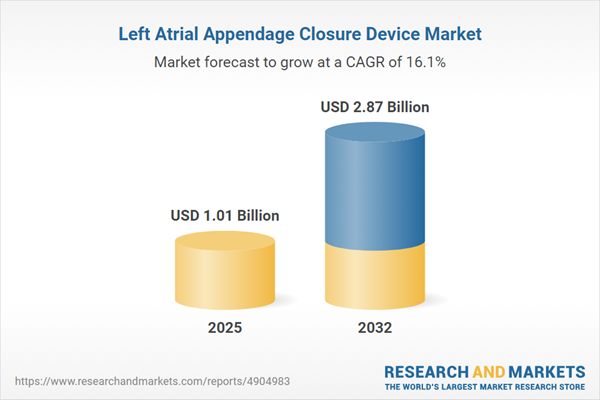Speak directly to the analyst to clarify any post sales queries you may have.
Senior decision-makers in healthcare are increasingly prioritizing the strategic integration of advanced cardiac technologies. The left atrial appendage closure device market has become pivotal in elevating operational performance, clinical compliance, and patient outcomes within cardiovascular care programs.
Market Snapshot: Left Atrial Appendage Closure Device Market
The global left atrial appendage closure device market is demonstrating strong momentum, with a current valuation of USD 870.45 million in 2024 and a projected increase to USD 1.01 billion by 2025. Forecasts indicate a Compound Annual Growth Rate (CAGR) of 16.12%, supporting an expansion to USD 2.87 billion in 2032.
Several factors are fueling this trajectory, including heightened demand for stroke prevention among atrial fibrillation patients not eligible for anticoagulation. Hospitals are rapidly embracing minimally invasive procedures, fostered by technical advances and close alignment with evolving clinical standards. Increasing regulatory scrutiny and innovation in device design further define the competitive landscape, making agility and adaptability essential for market participation.Scope & Segmentation in the Left Atrial Appendage Closure Device Market
A comprehensive understanding of market segmentation allows senior leaders to tailor decision-making based on facility needs, clinical workflows, and procurement strategies. This approach ensures that investments in left atrial appendage closure devices support sustainable hospital operations and enhance the quality of care.
- Device Types: Options such as Lariat, Watchman, Watchman 2, and Watchman Flx address diverse protocols and equip healthcare organizations with flexible solutions suitable for varying cardiology practices.
- Procedure Types: Both percutaneous and surgical interventions enable adaptable deployment in institutions with different procedural capabilities and case mixes.
- Payment Modes: Structures involving private and public insurance channels influence purchasing decisions and help organizations adjust to ongoing reimbursement and policy developments.
- Material Types: Advanced alloys like Nitinol and robust polymers drive device reliability, expanding the applicability of these solutions in both inpatient and outpatient settings.
- End Users: Core adoption centers include hospitals, cardiology centers, ambulatory clinics, and specialty facilities, each requiring distinct implementation and integration strategies within large health networks.
- Distribution Channels: Multiple procurement pathways, including direct sales, distributor networks, and digital platforms, offer resilience against supply chain disruptions and allow organizations to fine-tune sourcing strategies.
- Geographical Coverage: The U.S., Germany, China, Japan, and India represent key regions, each presenting unique regulatory challenges and investment climates that influence adoption rates and operational models.
- Company Coverage: Leading manufacturers such as Boston Scientific, Abbott Laboratories, Shenzhen Lepu Medical, LifeTech Scientific, Johnson & Johnson, Edwards Lifesciences, MicroPort Scientific, SentreHEART, Acutus Medical, and AtriCure anchor the sector, delivering innovation and ongoing product development.
Key Takeaways
- Minimally invasive technologies are transforming cardiac service lines, allowing for streamlined program expansion across health networks and consistent patient care delivery.
- Advances in device materials and the integration of digital imaging tools increase clinical precision while improving operational efficiency in cardiac departments.
- Strategic collaboration between manufacturers, clinicians, and regulators facilitates accelerated integration of new technologies and ensures alignment with best practice standards across healthcare environments.
- Adoption of remote monitoring and digital health platforms extends continuous patient oversight, supporting decentralized and regional cardiac programs with advanced connectivity.
- Flexible sourcing and secure digital procurement processes provide organizations with greater resilience, adapting to evolving supplier environments and minimizing risk to device availability.
- Leveraging real-time analytics and adaptive procurement models strengthens organizational ability to remain compliant and ensures uninterrupted device supply in the face of shifting regulatory priorities.
Tariff Impact: Navigating U.S. Policy Shifts
Recent U.S. tariff changes have introduced new cost considerations into the medical device supply chain, impacting how cardiac programs plan procurement. In response, many organizations are expanding supplier portfolios, forming robust domestic partner networks, and refining acquisition processes to mitigate procurement challenges and maintain consistent access to critical devices.
Methodology & Data Sources
Market findings draw from direct interviews with senior healthcare executives, consultation with subject-matter experts, and comprehensive surveys within top hospital systems. The research model incorporates supply chain analysis, regulatory documentation review, and clinical data assessment, ensuring all insights are reliable and actionable.
Why This Report Matters
- Enables cardiac program leaders to confidently develop and expand left atrial appendage closure services in alignment with strategic goals.
- Clarifies evolving market and regulatory dynamics, equipping organizations to anticipate and adapt their procurement strategies.
- Strengthens healthcare supply chain resilience by addressing operational and regulatory complexity.
Conclusion
By applying these market insights, healthcare organizations can speed the implementation of advanced cardiac technologies and support their leadership in evolving cardiovascular care.
Additional Product Information:
- Purchase of this report includes 1 year online access with quarterly updates.
- This report can be updated on request. Please contact our Customer Experience team using the Ask a Question widget on our website.
Table of Contents
3. Executive Summary
4. Market Overview
7. Cumulative Impact of Artificial Intelligence 2025
List of Figures
Companies Mentioned
The companies profiled in this Left Atrial Appendage Closure Device market report include:- Boston Scientific Corporation
- Abbott Laboratories
- Shenzhen Lepu Medical Technology Co., Ltd.
- LifeTech Scientific Corporation
- Johnson & Johnson
- Edwards Lifesciences Corp
- MicroPort Scientific Corporation
- SentreHEART, Inc.
- Acutus Medical, Inc.
- AtriCure, Inc.
Table Information
| Report Attribute | Details |
|---|---|
| No. of Pages | 184 |
| Published | November 2025 |
| Forecast Period | 2025 - 2032 |
| Estimated Market Value ( USD | $ 1.01 Billion |
| Forecasted Market Value ( USD | $ 2.87 Billion |
| Compound Annual Growth Rate | 16.1% |
| Regions Covered | Global |
| No. of Companies Mentioned | 11 |









